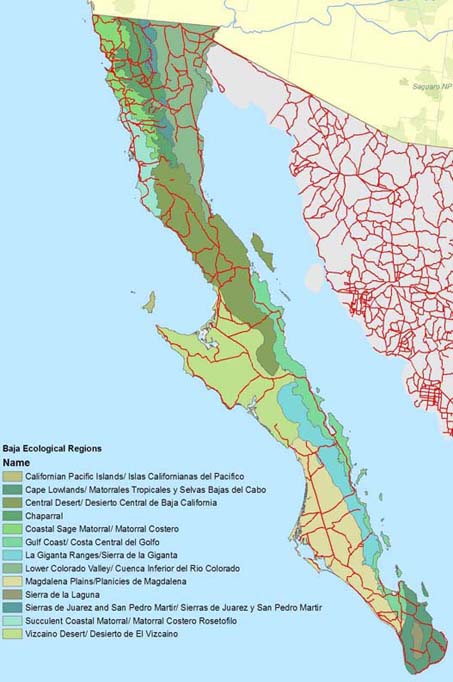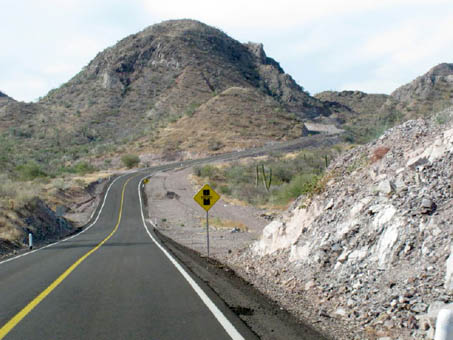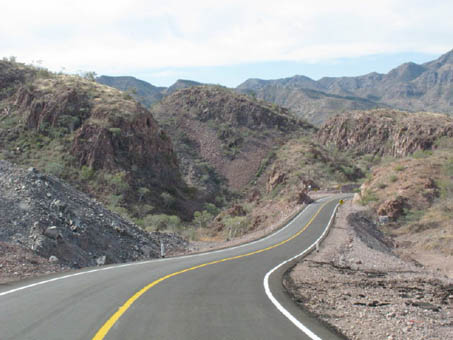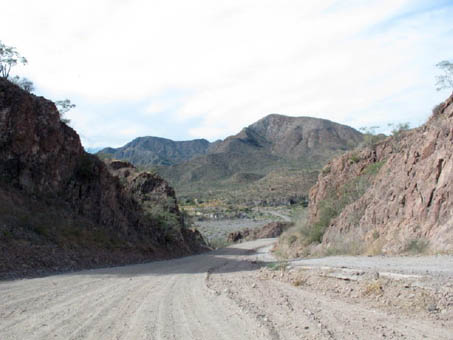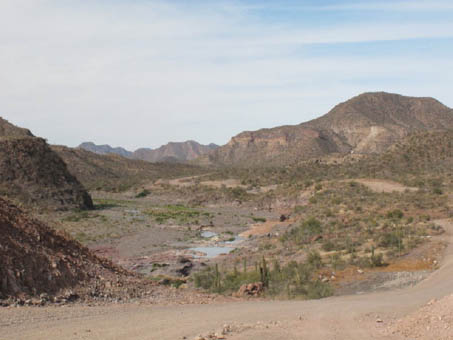BEE APRIL 2013
Mulegé Oasis Plants — San José de Magdalena Garlic and Wildflowers
A local phrase perfectly sums up the late winter weather here: febrero loco, marzo otro poco (basically: If you think February’s crazy, just wait ‘til March!).
It’s a matter of never knowing what to expect from one day to the next. It’s cold and dry. It’s cold and damp. It’s hot and dry. It’s windy, it’s calm, no it’s windy, no…
We’ve had more cloudy days than not and the month certainly came roaring in like a lion, with the first of eight days of consecutive northerly winds that blasted down the Gulf, first freezing then frying us. At this point, I can’t tell if the damage that many annual plants are showing is from frost or heat prostration or both.
Given the up-and-down weather, and swings between frosts and parching winds with temperatures in the mid 80’s, many of the plants really don’t know how to respond. Neither do we: what to wear?
In spite of the bad weather, we’ve tried to get out into the field when we can see through the dirt blowing around to check out what’s happening.
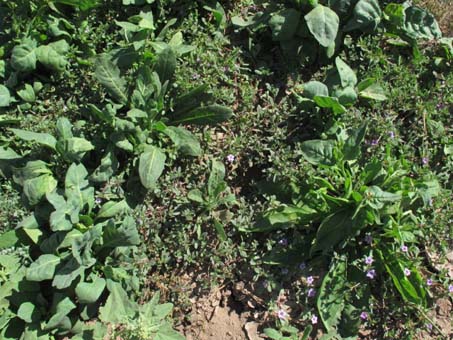
Plants on bank of ditch in late February. The large leafy plants are desert tobaccos, Nicotiana glauca (left & top) and N. clevelandii (right).
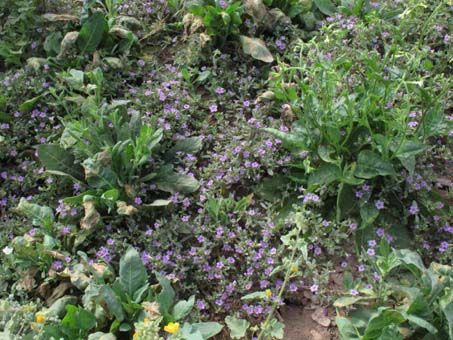
The same spot two weeks later. The Nama coulteri is thriving, but the Nicotiana glauca's larger leaves are drooping and damaged and the N. clevelandii seems to have bolted.
The Ditch Report — Feb 15 - Mar 7
The news in the ditch is both good and bad. First, some of the annuals that looked like they were doing fine were shriveled up after the latest bout of frost/heat. Surprisingly, there are still green mosses. Though most are a little crunchy to the touch, a few are getting by on whatever hint of moisture exists in the clay soil of the ditch bank.
Second, the cows are on the loose. The local rancher has moved his cows into the palm orchard and they are trampling and munching to their hearts content. While visiting the ditch the other day, I had to scoot a young steer down the canal and off of my study area. The bank’s days are surely numbered.
Good news is that a couple of the plants that I’ve been monitoring finally bloomed in early to mid March, making identification easier. One is the prostrate, semi-succulent annual Petunia parviflora, with delicate spreading stems to about 30 cm long and leaves and stems that are somewhat fleshy and sparkly from dense glandular hairs. The tiny purple tubular flowers are just 3-5 mm in diameter. This is the first time I’ve seen this species in Mulegé, and coincidentally I saw it again on one of our day trips up into the Sierras (see story below). It was already in bloom there, so I was able to key it out. When I returned to the ditch here a few days later, I found it was blooming at last so I was able to verify the identification.
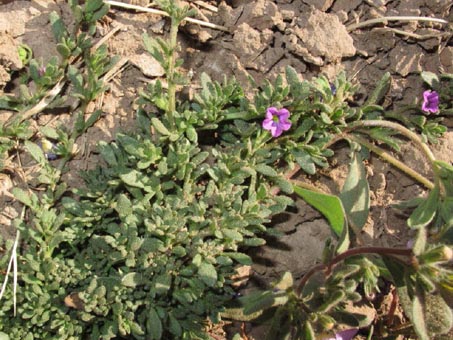
Petunia parviflora (Solanaceae)
Seaside petunia
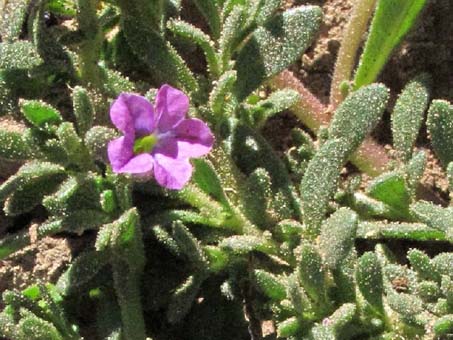
Petunia parviflora (Solanaceae)
Seaside petunia
This is a California and Baja California native, according to Calflora and the Jepson Manual species account. It is found in washes and dry stream beds in central to southern California, the Sonoran Desert and eastward across the southern US and northern Mexico.
Another plant that I have been tracking appears to be an Evening Primrose (Oenothera sp.).
Initially, I only saw two individuals in the ditch, both with lots of leaves, many flower buds, usually spent flowers, and no maturing fruit to help in the identification. Over the course of a couple of weeks, I was able to time my visit to capture the flowers while they were still open. They were going fast due to the hot wind. I’ve recently found a large population of the plants on the other side of the road in a smaller ditch where it is shadier. They are happily blooming and producing fruit, so hopefully I’ll be able to acquire some mature fruits to help in its identification before the cows totally stomp or munch them. (Update: this species was later identified as Oenothera kunthiana)
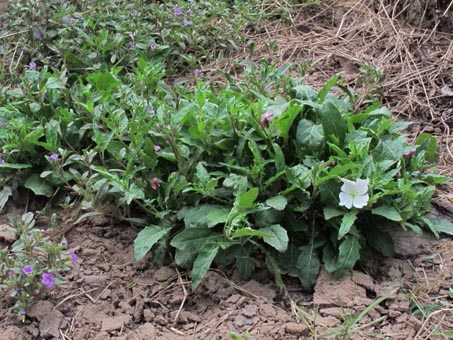
Another yet to be identified plant: Oenothera sp. (Onagraceae). This plant will not key out in Wiggins' "Flora of Baja California" and so it is likely to be one of the 1000+ species that weren't described in his 1980 work. Rats! (ID update: Oenothera kunthiana)
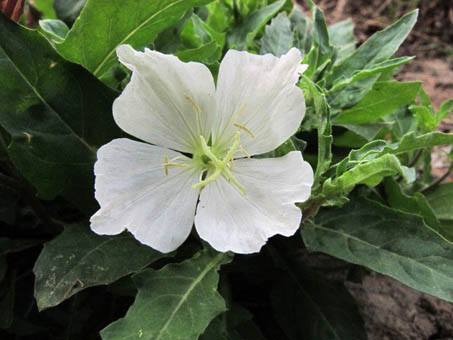
This flower is about 2.5 cm across and dries a dark purplish pink. Some plants are slightly bushy like the one pictured on the left with the flowers just poking out of the leaves, while other specimens in the area have more of a basal rosette with long, erect flowering stalks. (ID update: Oenothera kunthiana)
The Ditch Report — March 17 Update
Botanizing and collecting here is proving to be a serendipitous adventure. I was back at the ditch early this morning and saw that most of the plants were doing spectacularly well, now that the cold and hot winds have stopped and the day and nightime temperatures are slowly rising. Some of the desert tabaccos that a few weeks ago looked to be struggling have made a real comeback and have shown growth spurts, along with a bunch of the other weedy species. I gleefully hacked down several 1 meter high Cowthistles (Sonchus oleracea) and yanked a few invasive mustards as I went on my way. The sad news is that when I went back to see if the Indian Paintbrush (Castilleja bryantii) had blossomed more, all I found was a bare ditch bank about a meter wide where just about a week ago there was lush growth. Those bumbling bovines!
Beyond Mulegé — Feb 28 - Mar 15, 2013
We’ve had the opportunity to go on a few field trips with fellow botanists and nature enthusiasts over the past few weeks. Two of the day trips were to areas on the eastern edge of the Sierra de Guadalupe (considered to be within the Sonoran Desert's Sierra La Giganta Ecoregion. See light blue area on the map below). The mountains are mostly under 1500 meters in altitude, with sharp escarpments and deep canyons formed through water erosion of softer sedimentary deposits.
Our first trip took us to San José de Magdalena, a small town we have wanted to visit for at least 10 years. Somehow, we've never managed to make it, mostly due to the rough, washboard road that I knew would be too much for my back to handle. When we recently heard that the road had finally been paved, San José shot to the top of our to-do list.
The hamlet is only about 20 miles north of Mulegé on the highway and then less than 10 miles (15 km) to the west in the Sierras. It is known for its agriculture and the annual garlic festival in mid March. It is between 200 and 300 meters (650-980 feet) above sea level.
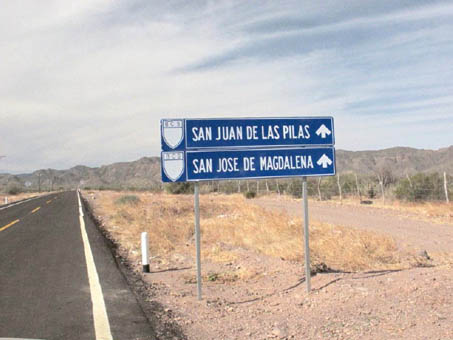
Leaving the Transpeninsular Highway and heading west away from the Gulf just south of San Bruno, BCS.
The paved road climbed quickly up into, and around, a series of steep hills, and in and out of a number of canyons, before running out at around Km. 8. So much for the up-to-date road conditions.
Fortunately, the road bed was graded for the next 8 km. and still in excellent condition as it awaited completion, which is supposedly scheduled for just after the Garlic Festival. Climbing up into the Sierras, we left behind the strong winds of the Gulf that had been buffeting the car during the trip north. We went up and over the steep hills and abruptly dropped into the Arroyo San José de Magdalena. It was an amazing view (above, right). The canyon is wide and deep, and in some places about half of the bottom is taken up by the rocky, gravelly river bed.
When we saw the tinajas (water holes) below us, our friend who was driving said, "we're going there!" and headed right for them, pulling off onto a side road that took us down into the river bed. It was a very special place.
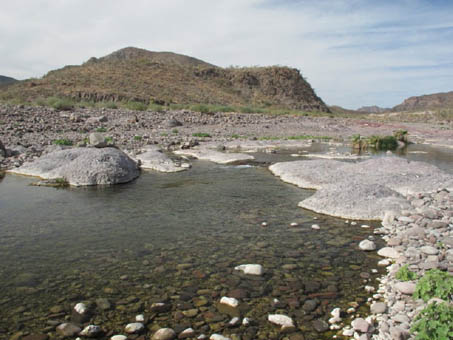
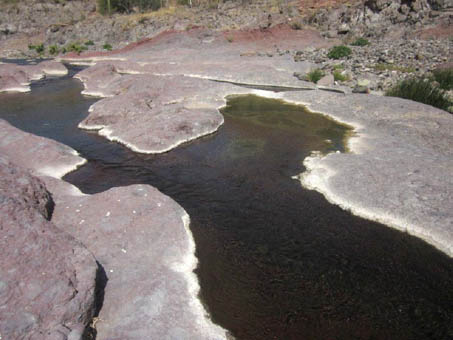
There was a lot more water than it seemed at first. If it had been a little warmer, we might have gone swimming in the deepest of the pools. As it was, the wind was hardly noticeable in the canyon and the soft sound of the river moving through the rocks cut out the rest of the world and the occasional passing car. After taking in the spectacular views, I couldn’t help but look around and start taking notes about the plants in view.
The vegetation in the river bottom near the edge of the streambed appeared to be very sparse and mostly consisted of the usual suspects I come across regularly in sandy, gravelly arroyo bottoms in Mulegé and much of southern Baja California. Turning my interest to the river banks and gravel berms, we started to walk upstream. Heading away from the water and slogging through the loose gravel and rocks, we came to the top of a berm and suddenly saw some other pools. I was ecstatic as these were lined with all types of plants in the wet dirt and gravel. Oh, heaven! Where to start?

Miraculously, the banks of this pool were untouched by livestock. Sprouts of many species were present.

Lopezia clavata, an endemic annual in the Evening-Primrose family (Onagraceae). Flowers are about 1 cm L. Of course, what wind there was came up just as I was trying for a closeup shot. Never got it.

The same pool as in the photo on the left, but taken beyond the rock on the top left corner.
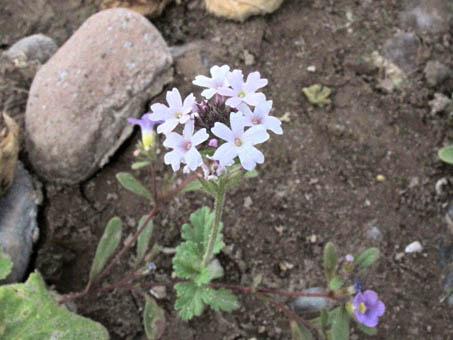
Verbena sp. (Verbenaceae)
Other plants around the ponds included some of the same species I've seen in the Mulegé ditch: Nama coulteri, Mimulus floribundus, Petunia parviflora, Nicotiana obtusifolia, and Oenothera kunthiana. Other plants, some new and some not, included: rabbitsfoot grass (Polypogon monspeliensis), Cyperus involucratus, Eleocharis geniculata, and the BCS endemic Amauria rotundifolia (Asteraceae).

That rounded bushy plant on the right at the edge of the pool is Erythranthe brevinasuta. It’s much more at home in the Sierra’s, where temperatures are slightly cooler and there is commonly above-ground water for much of the winter, especially after rainy summers.
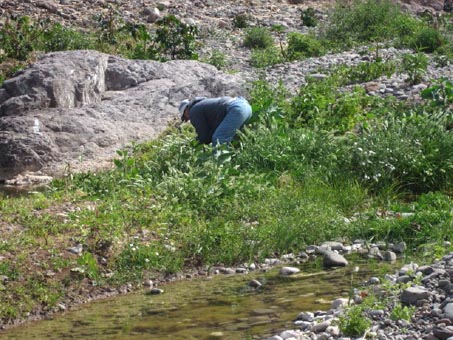
The ground was too wet and the plants too dense to get down on my belly. I could have stayed all day right here, scouring the banks.
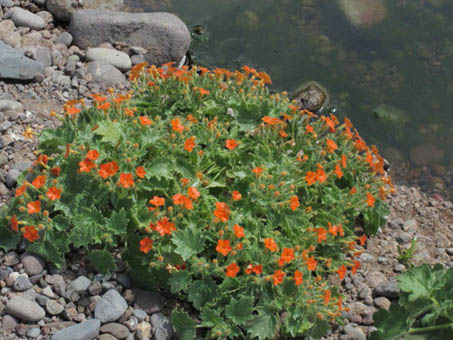
Eucnide aurea, or Pegapega, an endemic Rock Nettle (Loasaceae). The flowers, with their long tubes, are a hummingbird heaven.
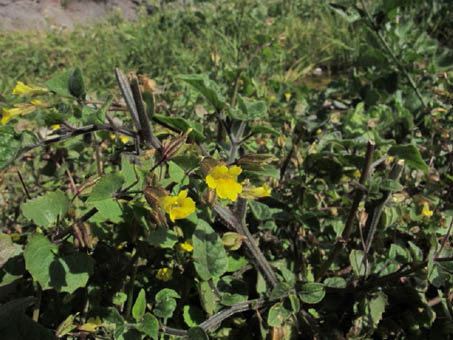
Closer view of Erythranthe brevinasuta. It was more than 60 cm (24 inches) tall and even broader, as well as much-branched. By comparison, the plants observed in the ditch in Mulegé were usually single-stemmed, under 30 cm (12 inches) tall and sparsely branched.
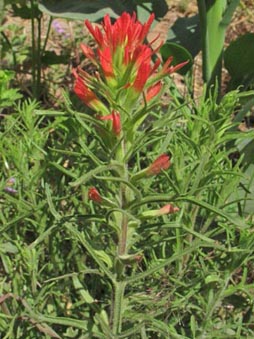
Castilleja bryantii, an endemic Paintbrush in Orobanchaceae.

Closeup of the flowers and leaves of Pegapega. The shiny leaves appear wet, but their surface is dry, resinous, and prickly.
After leaving the pools and the plants behind, we headed toward town to explore and get details about the garlic festival. As we headed upstream on the road, we came to a overlook high above the river. From there, we could see the first of the garlic fields in the distance, while below us was a rancho nestled on the hillside. In the riverbed below the rancho was a giant pool of water (photo, left). This pool, like most of the pools in the arroyo, lies atop conglomerate rock that was formed when an ash flow carrying volcanic pebbles and rocks, mainly of rhyolite, cooled and solidified. Todays pools become covered or uncovered with each flash flood. There is a naturally occurring rock dike running left to right above the pool that continues up into the hills on either side of the arroyo. At some point in the past it was breached by the raging river carrying a load of debris, knocking a huge chunk of it a little ways downstream (at bottom edge of the pool). Beyond the dike, the river turns sharply back towards the other side of the canyon and continues to snake up the arroyo.
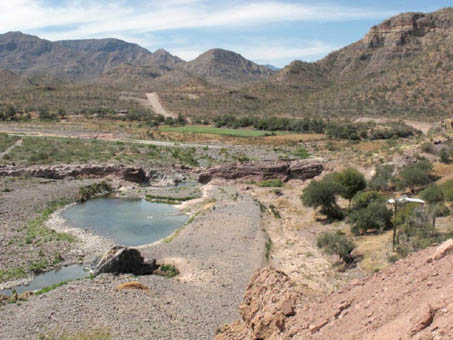
View from the overlook, with pool and rock dike (running L to R).

Crossing the river just east of the center of town.
The town is very small and spread out in the arroyo. As we pulled into what maybe seemed to be the main area, with church, rural boarding school, and 4 or 5 houses, someone called out to us "se vende ajo!". We had found the place to buy garlic. After greeting and shaking hands with all of the family members who were sitting around outside the house on a lovely Sunday afternoon, we started chatting, and finally got around to asking about the garlic they had for sale.
Soon we were being lead through the yard and up past the flower garden, animal pens, and dead truck to a small plot of land where the family grew their ajo. The young man sat down on his comfortable, padded seat (salvaged perhaps from the old truck), folded back the tarps he had covering his garlic stash, and started quickly braiding together the purple headed stalks of garlic. He tore two strips off of a fan palm leaf and used these to fasten each end of the braid. In no time at all, he had a new rama, or braid, which he added to his growing pile. We all bought ramas, including of course, the first one he created during his demonstration. Off to the side, in preparation for braiding, one of the women removed the loose bits and extra roots from the stalks of garlic. Their small plot was planted in August and harvested in late February. He said that the farmers staggered the planting of their garlic crops between August and October, and that the last of the crops to be ready for the festival were just starting to be harvested.
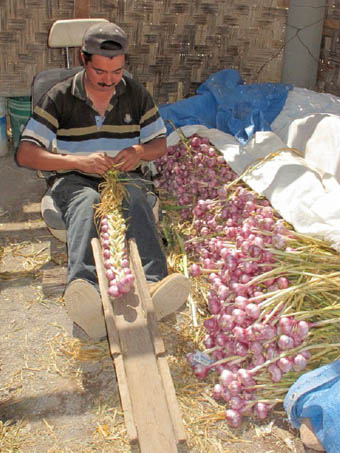 Young man braiding garlic (ajo). The ramas are sold all throughout the region.
Young man braiding garlic (ajo). The ramas are sold all throughout the region.
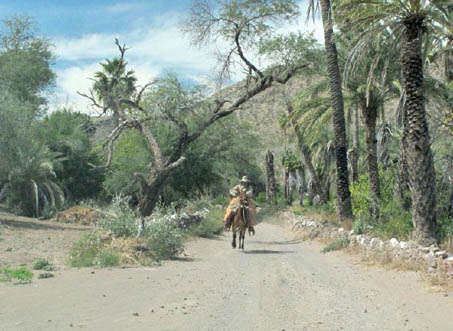
As we were making our way through town, we encountered this vaquero (cowboy) riding up on his mule. He had been out tending the cattle. Mules are preferred over horses because they are much hardier and sure-footed in the rough, loose terrain.
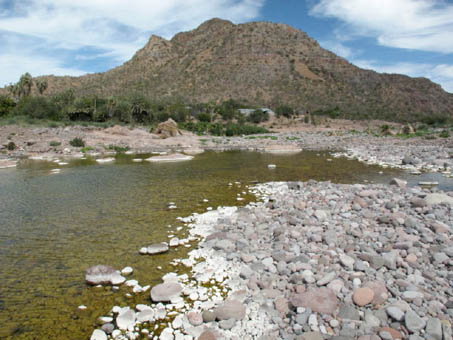
We picnicked at the river´s edge west of town before returning to Mulegé and the unrelenting Gulf winds.
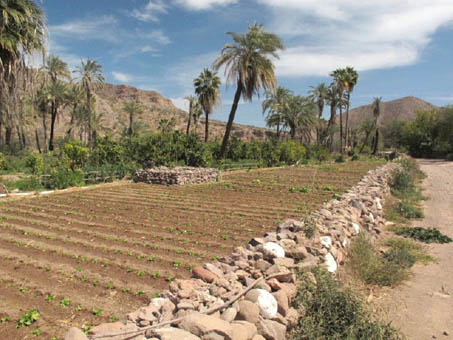
Recently planted plot, most likely with radishes. We had seen similar, but more advanced crops at the beginning of town. Native rock is used all over town to make walls for fields, corrals, and property lines.
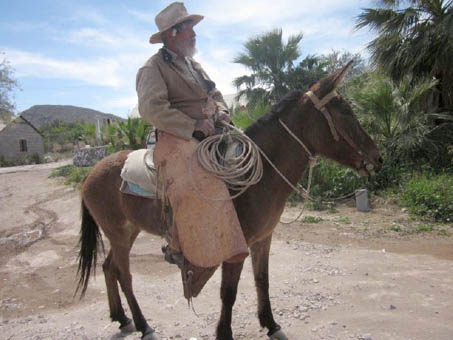
All of his leather gear, except his boots, were hand-made: the saddle (la montura) and the chaps (las chaparreras) came from Sonora. The calf protectors (las polainas) and spurs (las espuelas) were more local.
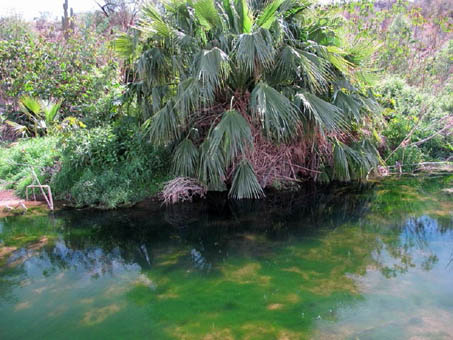
Pool behind a gravel berm at the edge of the river. Looking down into the pool, we could see big bubbles steadily coming up from the bottom. A young Washingtonia fan palm (Washingtonia robusta).
We had a terrific time in San José de Magdalena and we'll be heading back on March 16th for the Cabalgata (a community procession with cowfolk on horseback riding up the arroyo from the highway to town) and Festival. Fortunately for our group, this trip was only the first of several day trips which included nearby canyons and an oasis still filled with water left over from the summer rains. Click here to see photos from Arroyo San Patricio.
Arroyo San José de Magdalena Update — March 16
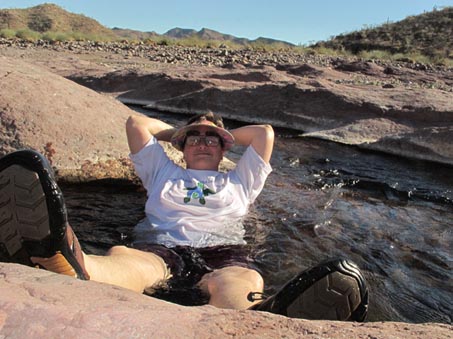 We were so lucky to have enjoyed the gorgeous ponds with their pristine vegetation a few weeks ago. Returning today to swim in the stream and rock pools before heading to the Festival, we found the banks of this pool trampled and entire plants denuded. The grasses, rock daisies and evening primroses had all been flattened by resting animals.
We were so lucky to have enjoyed the gorgeous ponds with their pristine vegetation a few weeks ago. Returning today to swim in the stream and rock pools before heading to the Festival, we found the banks of this pool trampled and entire plants denuded. The grasses, rock daisies and evening primroses had all been flattened by resting animals.
And the enormous Monkeyflower? Nothing but a shadow of its former self, a tiny nub of its stem sticking out of the mud! My spirits plummeted and I had to go cool off and console myself, submerged in the clean, refreshing stream as it flowed through the narrow channels of the tinajas.
We were doubly fortunate to have been able to witness and record the ephemeral beauty of Baja California's desert plant life. So, I will now give my requisite shrug of the shoulders, and for good measure, add the Mexican verbal equivalent "Ni modo..." and be on the lookout for the next amazing sight.
Stay tuned for next month's entry...
— Debra Valov, curatorial volunteer









